The NVIDIA GeForce GTX Titan X Review
by Ryan Smith on March 17, 2015 3:00 PM ESTCompute
Shifting gears, we have our look at compute performance.
As we outlined earlier, GTX Titan X is not the same kind of compute powerhouse that the original GTX Titan was. Make no mistake, at single precision (FP32) compute tasks it is still a very potent card, which for consumer level workloads is generally all that will matter. But for pro-level double precision (FP64) workloads the new Titan lacks the high FP64 performance of the old one.
Starting us off for our look at compute is LuxMark3.0, the latest version of the official benchmark of LuxRender 2.0. LuxRender’s GPU-accelerated rendering mode is an OpenCL based ray tracer that forms a part of the larger LuxRender suite. Ray tracing has become a stronghold for GPUs in recent years as ray tracing maps well to GPU pipelines, allowing artists to render scenes much more quickly than with CPUs alone.
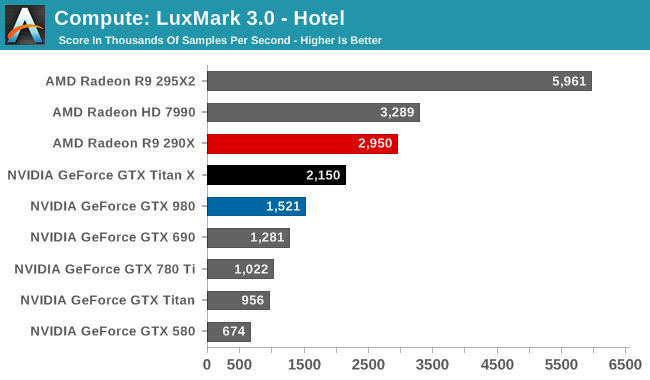
While in LuxMark 2.0 AMD and NVIDIA were fairly close post-Maxwell, the recently released LuxMark 3.0 finds NVIDIA trailing AMD once more. While GTX Titan X sees a better than average 41% performance increase over the GTX 980 (owing to its ability to stay at its max boost clock on this benchmark) it’s not enough to dethrone the Radeon R9 290X. Even though GTX Titan X packs a lot of performance on paper, and can more than deliver it in graphics workloads, as we can see compute workloads are still highly variable.
For our second set of compute benchmarks we have CompuBench 1.5, the successor to CLBenchmark. CompuBench offers a wide array of different practical compute workloads, and we’ve decided to focus on face detection, optical flow modeling, and particle simulations.
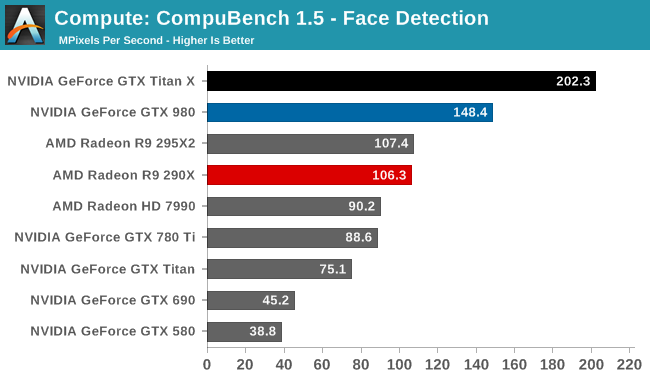
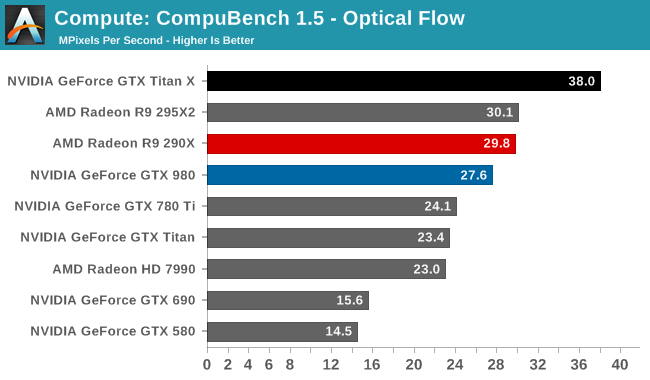
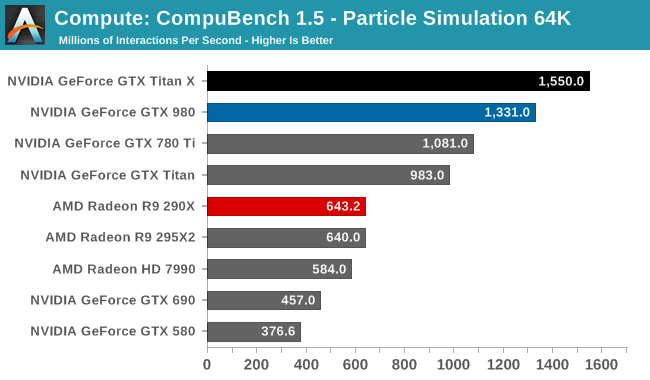
Although GTX Titan X struggled at LuxMark, the same cannot be said for CompuBench. Though the lead varies with the specific sub-benchmark, in every case the latest Titan comes out on top. Face detection in particular shows some massive gains, with GTX Titan X more than doubling the GK110 based GTX 780 Ti's performance.
Our 3rd compute benchmark is Sony Vegas Pro 13, an OpenGL and OpenCL video editing and authoring package. Vegas can use GPUs in a few different ways, the primary uses being to accelerate the video effects and compositing process itself, and in the video encoding step. With video encoding being increasingly offloaded to dedicated DSPs these days we’re focusing on the editing and compositing process, rendering to a low CPU overhead format (XDCAM EX). This specific test comes from Sony, and measures how long it takes to render a video.

Traditionally a benchmark that favors AMD, GTX Titan X closes the gap some. But it's still not enough to surpass the R9 290X.
Moving on, our 4th compute benchmark is FAHBench, the official Folding @ Home benchmark. Folding @ Home is the popular Stanford-backed research and distributed computing initiative that has work distributed to millions of volunteer computers over the internet, each of which is responsible for a tiny slice of a protein folding simulation. FAHBench can test both single precision and double precision floating point performance, with single precision being the most useful metric for most consumer cards due to their low double precision performance. Each precision has two modes, explicit and implicit, the difference being whether water atoms are included in the simulation, which adds quite a bit of work and overhead. This is another OpenCL test, utilizing the OpenCL path for FAHCore 17.
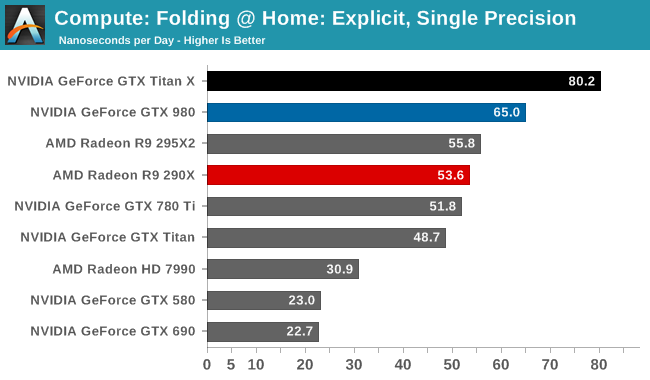
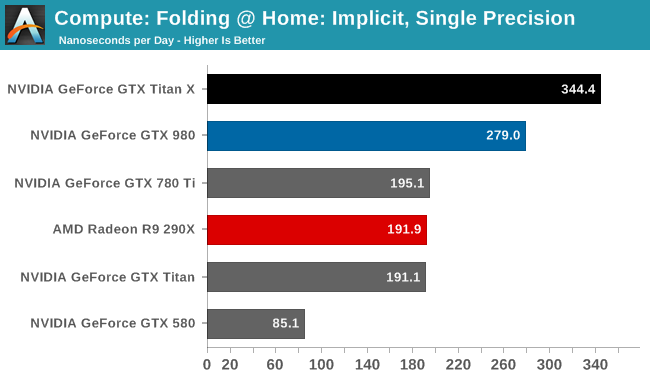
Folding @ Home’s single precision tests reiterate just how powerful GTX Titan X can be at FP32 workloads, even if it’s ostensibly a graphics GPU. With a 50-75% lead over the GTX 780 Ti, the GTX Titan X showcases some of the remarkable efficiency improvements that the Maxwell GPU architecture can offer in compute scenarios, and in the process shoots well past the AMD Radeon cards.
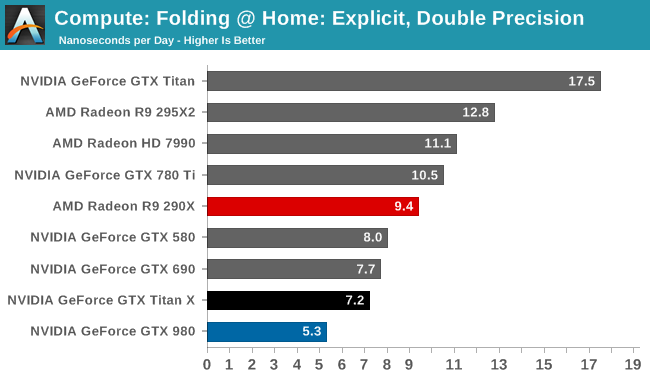
On the other hand with a native FP64 rate of 1/32, the GTX Titan X flounders at double precision. There is no better example of just how much the GTX Titan X and the original GTX Titan differ in their FP64 capabilities than this graph; the GTX Titan X can’t beat the GTX 580, never mind the chart-topping original GTX Titan. FP64 users looking for an entry level FP64 card would be well advised to stick with the GTX Titan Black for now. The new Titan is not the prosumer compute card that was the old Titan.
Wrapping things up, our final compute benchmark is an in-house project developed by our very own Dr. Ian Cutress. SystemCompute is our first C++ AMP benchmark, utilizing Microsoft’s simple C++ extensions to allow the easy use of GPU computing in C++ programs. SystemCompute in turn is a collection of benchmarks for several different fundamental compute algorithms, with the final score represented in points. DirectCompute is the compute backend for C++ AMP on Windows, so this forms our other DirectCompute test.
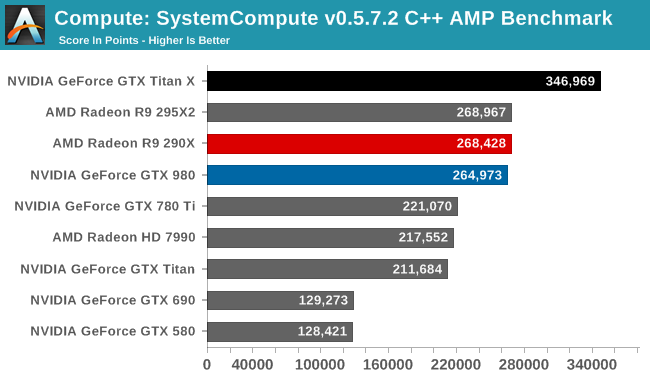
With the GTX 980 already performing well here, the GTX Titan X takes it home, improving on the GTX 980 by 31%. Whereas GTX 980 could only hold even with the Radeon R9 290X, the GTX Titan X takes a clear lead.
Overall then the new GTX Titan X can still be a force to be reckoned with in compute scenarios, but only when the workloads are FP32. Users accustomed to the original GTX Titan’s FP64 performance on the other hand will find that this is a very different card, one that doesn’t live up to the same standards.










276 Comments
View All Comments
Braincruser - Wednesday, March 18, 2015 - link
The titan was teased 10 days ago...Tunnah - Wednesday, March 18, 2015 - link
It feels nVidia are just taking the pee out of us now. I was semi-miffed at the 970 controversy, I know for business reasons etc. it doesn't make sense to truly trounce the competition (and your own products) when you can instead hold something back and keep it tighter, and have something to release in case they surprise you.And I was semi-miffed when I heard it would be more like a 33% improvement over the current cream of the crop, instead of the closer to 50% increase the Titan was over the 680, because they have to worry about the 390x, and leave room for a Titan X White Y Grey SuperHappyTime version.
But to still charge $1000 even though they are keeping the DP performance low, this is just too far. The whole reasoning for the high price tag was you were getting a card that was not only a beast of a gaming card, but it would hold its own as a workstation card too, as long as you didn't need the full Quadro service. Now it is nothing more than a high end card, a halo product...that isn't actually that good!
When it comes down to it, you're paying 250% the cost for 33% more performance, and that is disgusting. Don't even bring RAM into it, it's not only super cheap and in no way a justification for the cost, but in fact is useless, because NO GAMER WILL EVER NEED THAT MUCH, IT WAS THE FLIM FLAMMING WORKSTATION CROWD WHO NEEDING THAT FLIM FLAMMING AMOUNT OF FLOOMING RAM YOU FLUPPERS!
This feels like a big juicy gob of spit in our faces. I know most people bought these purely for the gaming option and didn't use the DP capability, but that's not the point - it was WORTH the $999 price tag. This simply is not, not in the slightest. $650, $750 tops because it's the best, after all..but $999 ? Not in this lifetime.
I've not had an AMD card since way back in the days of ATi, I am well and truly part of the nVidia crowd, even when they had a better card I'd wait for the green team reply. But this is actually insulting to consumers.
I was never gonna buy one of these, I was waiting on the 980Ti for the 384bit bus and the bumps that come along with it...but now I'm not only hoping the 390x is better than people say because then nVidia will have to make it extra good..I'm hoping it's better than they say so I can actually buy it.
For shame nVidia, what you're doing with this card is unforgivable
Michael Bay - Wednesday, March 18, 2015 - link
So you`re blaming a for-profit company for being for-profit.maximumGPU - Wednesday, March 18, 2015 - link
no he's not. He's blaming a for-profit compaby abusing it's position at the expense of its customers.Maxwell is great, and i've got 2 of them in my rig. But titan X is a bit of a joke. The only justification the previous titan had was that it could be viewed as a cheap professional cards. Now that's gone but you're still paying the same price.
Unfortunately nvidia will put the highest price they can get away with, and 999$ doesn't seem to deter some hardcore fans no matter how much poor value it represents.
I certainly hope the sales don't meet their expectations.
TheinsanegamerN - Wednesday, March 18, 2015 - link
I would argue that the vram may be needed later on. 4GB is already tight with SoM, and future games will only push that up.people said that 6GB was too much for the OG titan, but SoM can eat that up at 4k, and other games are not far behind. especially for SLI setups, that memory will come in handy.
Thats what really killed the 770. gpu was fine for me, but 2GB was way to little vram.
Tal Greywolf - Wednesday, March 18, 2015 - link
Not being a gamer, I would like to see a review in which many of these top-of-the-line gaming cards are tested against a different sort of environment. For example, I'd love to see how cards compare handling graphics software packages such as Photoshop, Premier Pro, Lightwave, Cinema 4D, SolidWorks and others. If these cards are really pushing the envelope, then they should compare against the Quadro and FirePro lines.Ranger101 - Wednesday, March 18, 2015 - link
I think it's safe to say that Nvidia make technically superior cards as compared to AMD,at least as far as the last 2 generations of GPUs are concerned. While the AMD cards consume
more power and produce more heat, this issue is not a determining factor when I upgrade unlike
price and choice.
I will not buy this card, despite the fact that I find it to be a very desirable and
techically impressive card, because I don't like being price-raped and because
I want AMD to be competitive.
I will buy the 390X because I prefer a "consumer wins" situation where there are at least 2
companies producing competitive products and lets be clear AMD GPUs are competitve, even when you factor in what is ultimately a small increase in heat and noise, not to mention lower prices.
It was a pleasant surprise to see the R295X2 at one point described as "very impressive" yet
I think it would have been fair if Ryan had drawn more attention to AMD "wins," even though they
are not particularly significant, such as the most stressful Shadow of Mordor benchmarks.
Most people favour a particular brand, but surely even the most ardent supporters wouldn't want to see a situation where there is ONLY Intel and ONLY Nvidia. We are reaping the rewards of this scenario already in terms of successive generations of Intel CPUs offering performance improvements that are mediocre at best.
I can only hope that the 390X gets a positive review at Anandtech.
Mystichobo - Wednesday, March 18, 2015 - link
Looking forward to a 390 with the same performance for 400-500. I certainly got my money's worth out of the r9 290 when it was released. Don't understand how anyone could advocate this $1000 single card price bracket created for "top tier".Geforce man - Wednesday, March 18, 2015 - link
What still frustrates me, is the lack of using a modern aftermarket r9 290/x.Crunchy005 - Wednesday, March 18, 2015 - link
I actually really like how the new titan looks, shows what can be done. The problem with this card at this price point is it defeats what the titan really should be. Without the couple precision performance this card becomes irrelevant I feel(overpriced gaming card). The original titan was an entry level compute card outside of the quadro lineup. I know there are drawbacks to multiGPU setups but I would go for 2 980's or 970's for same or less money than the Titan X.I also found these benchmarks very interesting because you can see how much each game can be biased to a certain card. AMDs 290x, an old card, beat out the 980 in some cases, mostly at 4k resolutions and lost in others at the same resolution. Just goes to show that you also have to look at individual game performance as well as overall performance when buying a card.
Can't wait for the 390x from AMD that should be very interesting.